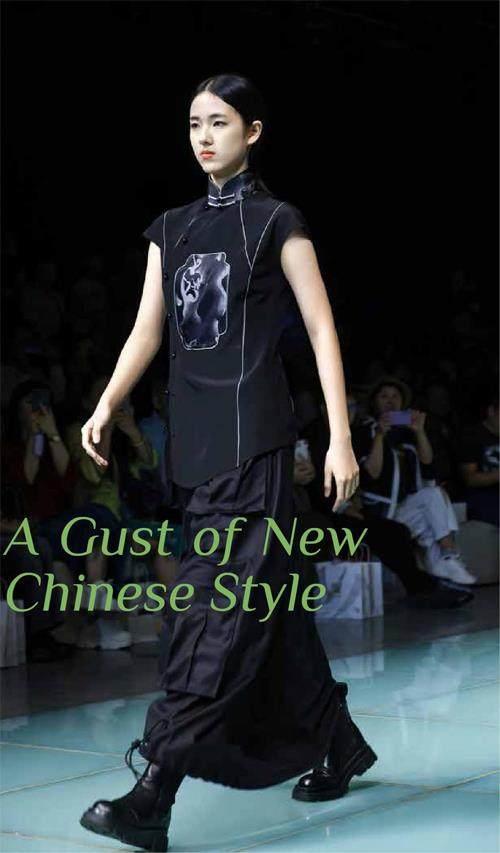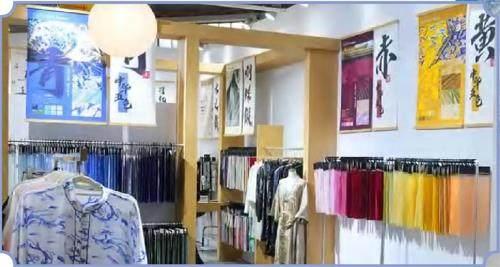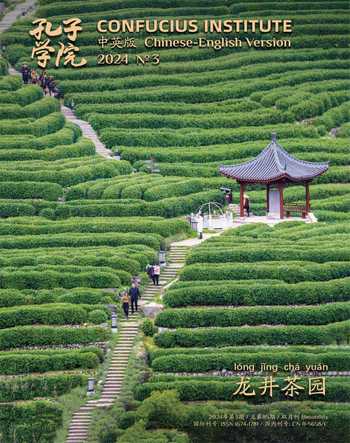流行的“新中式”A Gust of New Chinese Style
言真 夕柚


龙年春节期间,在中国的一些城市,穿着传统汉服或中国少数民族服饰可以免费乘坐地铁,甚至还有一些景区对穿汉服的游客免费开放;越来越多的明星穿上各种“新中式”服装在各种重大场合频频亮相;年轻人也正追逐着这股新中式的潮流。如今,新中式的设计之美甚至超越国界,成为全球时尚界的一股重要力量。
During the Spring Festival of the Yearof the Loong, in some cities of China,people wearing traditional Han Chineseclothing, known as Hanfu, or costumes ofChinese ethnic minorities enjoy free ride onthe subway. In some scenic spots, visitorswearing Hanfu also enjoy free entry. Moreand more celebrities are donning various“new Chinese-style” clothing at major events,while young people are enthusiasticallyfollowing this trend. Today, the beauty ofnew Chinese-style design has gone global,becoming an important force in the fashionworld.
说到穿衣风格,人们比较耳熟能详的有法式风、英伦风、美式风。那么,新中式到底是什么?为此我们采访了中国十佳时装设计师、中国时装设计“金顶奖”获得者武学凯,为我们解析他眼中的新中式。
When it comes to fashion styles, peopleare more familiar with French, British, andAmerican styles. So, what exactly is NewChinese-style? To answer this question, weinterviewed Wu Xuekai, one of Chinas topten fashion designers and recipient of the“Jinding Award” for Chinese fashion design,to decipher his perspective on new Chinesestyle.
新中式的要素
Elements of New Chinese Style
新中式,从某种意义上说,是中国当代年轻艺术家将自己对中国传统文化内涵的理解,结合多种元素,转化成现代艺术表达的一种呈现。
New Chinese style, in a sense, is a presentationof contemporary understanding and modern artisticexpression of the cultural connotations of Chinesetraditions combined with various elements by Chineseyoung artists.
新中式的第一大要素在于面料。过去人们讲到新中式,首先想到的可能是服装样式,但是现在的新中式更讲究面料。武学凯联手非遗染缬(xié)传承人管兰生教授研制面料。他们将采集的植物枝叶、花朵等与非遗染缬技术相结合,在棉、麻、丝等天然及混纺材质上实现千万种变化,使其呈现出独一无二的面料样式。同时,他们将科技与可持续发展的环保理念相结合,通过时尚设计提高人们的生活品质。
The first major element of new Chinese style lies inthe fabrics. In the past, when people talked about newChinese style, they might have first thought of clothingstyles, but nowadays, emphasis has been placed onfabrics. Wu Xuekai collaborated with Professor GuanLansheng, an inheritor of traditional dyeing techniqueswhich has been listed as intangible cultural heritage,to develop the fabrics for new Chinese-style garments.They used plant branches, leaves, and flowers as rawmaterials, and adopted traditional dyeing techniques,creating countless unique styles on natural andblended materials such as cotton, hemp, and silk.At the same time, they embraced the conceptsof sustainable development and environmentalprotection in technological advancement,improving peoples quality of life through fashiondesign.
武学凯最近设计的“锦绣岁贡”系列是与故宫文创联名开发的故宫IP丝绸面料,力求全方位地复刻与发扬中国优秀文化传统。选用讲究的桑蚕丝为面料,以独有的AI人工智能织造技术为支撑,“锦绣岁贡”系列面料先后获得“中国国际面料设计大赛”金奖、“中国国际丝绸博览会推荐精品”金奖等多项国内外奖项,以及国家发明专利,使过往无法想象的无极渐变和繁复图案都变为现实。
Wu Xuekais recently designed “SplendidTribute” series is a collaboration with the PalaceMuseums Cultural and Creative Products,developing silk fabrics featuring the PalaceMuseum IP. The series is aimed at meticulouslyreplicating and promoting traditional Chinesecultural heritage in every aspect. By selectingexquisite mulberry silk as the fabric and utilizingunique artificial intelligence weaving technology,the “Splendid Tribute” series has won manydomestic and international awards such asthe gold award of China International FabricDesign Competition, and the gold award ofRecommended Products of China InternationalSilk Expo. It has also successfully acquired manynational invention patents. The series has madethe previously unimaginable infinite gradients andintricate patterns a reality.
新中式的第二大要素在于颜色。国际通用的彩通(PANTONE)色卡会把颜色分得非常细致,如绿色能细分到草绿色、橄榄绿色等,但在呈现中国颜色时,就会使用到各种各样的物件,如古代中式的盆景、团扇、花瓶等,这些物件赋予颜色各种情绪和内涵,颜色因而富有诗意。
The second major element of new Chinesestyle is color. The internationally recognizedPantone color card divides colors very finely,such as green being subdivided into grass green,olive green, etc. But Chinese colors are definedthrough various daily items, such as ancientbonsai, folding fans, vases, etc. These objectsinfuse Chinese colors with a poetic quality withspecific emotions and cultural implications.
新中式的第三大要素在于设计和款式。新中式的服装设计具有唯一性和偶然性。一些新中式服装需要手工植物染色,染色后的效果往往不可预料:虽然是用同一种方法去染面料,但由于每次染色时的温度、手法、力度等有些不同,每一批面料上的花纹都可能是不同的。这些偶然性成就了新中式服装的唯一性。
The third major element of new Chinesestyle exists in design and style. new Chinesestyleclothing design boasts uniqueness andrandomness. Some new Chinese-style clothingrequires hand-dyeing with plant dyes, whichcreates unforeseeable effects: although the samemethod is used to dye the fabrics, differencesin temperature, technique, and pressure duringeach dyeing process may result in differentpatterns on each batch of fabrics. These randomoccurrences contribute to the uniqueness ofnew Chinese-style clothing.
新中式服装款式众多。传统的中式服装经过改良和更新,融合现代设计元素,更具时尚感和个性化,并适宜在多种场合穿着。以前,人们会觉得某些服装,比如西服和旗袍,必须要有一定经验的老师傅才能设计。而现在,新中式的设计追求的是一种娱乐性的有趣表达,年轻的设计师也适宜做新中式。可以通过不同的方式产生那些唯一性和偶然性,这也是新中式的设计师群体越来越年轻化的原因。此外,消费者的眼光也变得更包容。新中式的消费者往往不追求完美,反而喜欢具有特色的东西。如此,设计师的创新能力得以释放,这便是近年来中国设计师在国际上越来越受到关注和认可的原因之一。
New Chinese-style clothing encompasses awide range of styles. Traditional Chinese clothinghas been improved and updated with moderndesign elements, thus more fashionable andpersonalized, and suitable for various occasions.In the past, people would think that certainclothing, such as suits and Qipaos, could only bedesigned by experienced master tailors. However,now, the pursuit of new Chinese-style design isfor an entertaining and interesting expression,and therefore young designers are also suitablefor creating new Chinese-style clothing.The uniqueness and randomness throughdifferent methods is also why the group of newChinese-style designers is becoming younger.Furthermore, consumers tastes have becomemore diverse. New Chinese-style consumersoften value uniqueness over perfection. As aresult, the designers creativity is unleashed. Thisis one of the reasons why Chinese designers havebeen increasingly recognized and celebratedinternationally in recent years.
新中式是一种文化符号
New Chinese Style as a Cultural Symbol
新中式的第四大要素在于文化符号。相同款式的服装怎样做到千变万化、富有创意、富有民族情怀?新中式找到了它的“最佳搭档”——IP联名,无论是故宫联名面料,还是各种国潮、非遗文化的联名款服饰,都给新中式服装标上了“中国文化”的符号。当服装与文化结合、碰撞出新的火花时,便引发了服装品牌与中式文化融合的热潮。
The fourth major element of newChinese style is the cultural symbols. Howcan clothing of the same style presentvariety, creativity, and national sentiment?New Chinese style has found its “bestpartner” — IP collaboration. Whether itsthe Palace Museums co-branded fabrics orvarious Chinese-style intangible culturalheritage co-branded clothing, they all bearthe symbol of “Chinese culture” for newChinese-style clothing. When clothingis combined with culture and new ideasspark, a fashion trend of integration iscreated.
随着对全球认知的加深,越来越多的中国人走出国门,人们对世界文化的了解越清晰,对自我表达的渴望也越强烈。此外,非遗文化也极大地激发了传统文化的新活力。为何近年来非遗持续火热?武学凯认为,国际间交往的机会越多,中国设计师就越能感受到中国优秀传统文化是一个宝库,好的服装就是用国际语言来展现民族文化。设计师并非刻意创造新中式国潮,而是和消费者一起找到了一种名为“共情共鸣”的时尚空间。如今,在很多大型宴会上,人们不再只穿国外的大牌礼服,也会选择穿汉服或新中式服装——这就是文化符号的体现,传播的价值也因此变得不同。
As global awareness deepens, more and moreChinese people are going abroad, contributing to aclearer understanding of global cultures and a strongerdesire for self-expression. Additionally, intangiblecultural heritage has greatly invigorated traditionalculture. Why has intangible cultural heritage been sopopular in recent years? Wu Xuekai believes that withmore international exchanges, Chinese designers willincreasingly recognize that Chinese traditional cultureis a treasure trove. He believes that good clothingshowcases ethnic culture with an international language.Designers are not deliberately creating a new Chinesestyletrend, but rather, they are finding a fashion spacecalled “empathy and resonance” with consumers. Today,at many large banquets, apart from the initial optionsof foreign designer dresses, people also choose to wearHanfu or new Chinese-style clothing, an embodiment ofChinas cultural symbols. With such changes, the culturalsignificance of new Chinese-style clothing has increased.
新中式是中国当代生活美学的兴起
New Chinese Style Symbolizes New Lifestyle Aesthetics in Modern China
武学凯主张要“让生活艺术化,让艺术生活化”。随着年轻人对中国优秀传统文化的重视和接受程度的逐渐加深,新中式文化的符号和意象也开始渗入当代生活的方方面面:从博物馆到各种电视节目、鉴宝活动、非遗项目,一些文物国宝IP甚至融入了日常生活用品。一个带有中国文物元素的盘子不仅看上去精美,还非常实用,这就是文化与生活的融合。有了这样的融合,历史的文化便得以延续,这是造物哲学的完美体现。与商业相结合、与消费形成共通共振,设计因此有了价值。
Wu Xuekai advocates for “artifying lifeand making art part of life.” As young peopleincreasingly accept and value traditionalChinese culture, symbols and imagery ofnew Chinese-style culture begin to permeatevarious aspects of contemporary life: frommuseums to television programs, antiqueappraisal events, and intangible culturalheritage projects. Many cultural relics andnational treasure IPs are even integratedinto daily necessities. A plate adorned with elements of Chinese cultural relics not onlylooks exquisite but also proves to be verypractical, illustrating the fusion of culture andlife. With such integration, historical culturecan continue, which is a perfect embodimentof the philosophy of creation. Designers areusing more cultural elements in commercialproducts, boosting consumption andincreasing the design value at the same time.
过去,世界曾因文化、审美的不同对中国抱有误解。如今,中国的设计师希望通过新中式服装来传递中国当代生活美学的声音,打破那些误解,告诉世界我们现在的美是什么样的,我们还有很多美的地方。
Once, the world misunderstood Chinadue to differences in culture and aesthetics.Today, Chinese designers hope to express thevoice of contemporary aesthetic lifestyle inChina through new Chinese-style clothing,breaking those misunderstandings andshowing the world what Chinese beautylooks like and where it lies.

